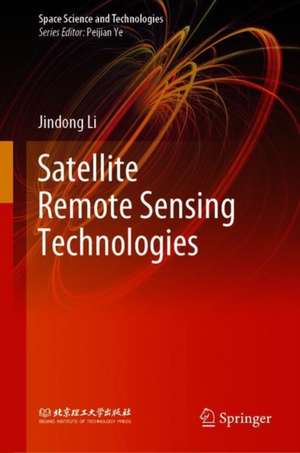Satellite Remote Sensing Technologies: Space Science and Technologies
Autor Jindong Lien Limba Engleză Hardback – 30 aug 2020
| Toate formatele și edițiile | Preț | Express |
|---|---|---|
| Paperback (1) | 1223.88 lei 6-8 săpt. | |
| Springer Nature Singapore – 30 aug 2021 | 1223.88 lei 6-8 săpt. | |
| Hardback (1) | 1230.03 lei 6-8 săpt. | |
| Springer Nature Singapore – 30 aug 2020 | 1230.03 lei 6-8 săpt. |
Preț: 1230.03 lei
Preț vechi: 1500.04 lei
-18% Nou
Puncte Express: 1845
Preț estimativ în valută:
235.39€ • 255.60$ • 197.73£
235.39€ • 255.60$ • 197.73£
Carte tipărită la comandă
Livrare economică 23 aprilie-07 mai
Preluare comenzi: 021 569.72.76
Specificații
ISBN-13: 9789811548703
ISBN-10: 9811548706
Ilustrații: XXIII, 421 p. 158 illus., 12 illus. in color.
Dimensiuni: 155 x 235 mm
Greutate: 0.8 kg
Ediția:1st ed. 2021
Editura: Springer Nature Singapore
Colecția Springer
Seria Space Science and Technologies
Locul publicării:Singapore, Singapore
ISBN-10: 9811548706
Ilustrații: XXIII, 421 p. 158 illus., 12 illus. in color.
Dimensiuni: 155 x 235 mm
Greutate: 0.8 kg
Ediția:1st ed. 2021
Editura: Springer Nature Singapore
Colecția Springer
Seria Space Science and Technologies
Locul publicării:Singapore, Singapore
Cuprins
Fundamentals of Satellite Remote Sensing Technology.- Space Orbit Design of Remote Sensing Satellite.- Analysis and Design of High-resolution Visible Spectral Remote Sensing Satellite System.- Design and Analysis of Infrared Remote Sensing Satellite System.- Design and Analysis of Hyperspectral Remote Sensing Satellite System.- Design and Analysis of High-Precision Stereo Surveying and Mapping Satellite System.- Design and Analysis of High Resolution SAR Remote Sensing Satellite System.- Design and Analysis of High Precision Microwave Remote Sensing Satellite System.- Design and Analysis of Optical Remote Sensing Satellite System on Geostationary Orbit.- Development Prospect.
Notă biografică
Professor Jindong Li is a Research Engineer who has specialized in spacecraft remote sensing. He is currently working as a Chief Designer at Institute of Spacecraft System Engineering,CAST. As a respected expert on satellite system design and thermal control technologies, Dr. Li was e.g. the Chief Technologist for the “973 Project.” He has won the National Prize for Progress in Science and Technology and the National Defense Science and Technology Prize on several occasions, and has published more than 80 papers in prominent journals and conference proceedings.
Textul de pe ultima copertă
This book provides in-depth explanations of design theories and methods for remote sensing satellites, as well as their practical applications. There have been significant advances in spacecraft remote sensing technologies over the past decade. As the latest edition of the book “Space Science and Technology Research,” it draws on the authors’ vast engineering experience in system design for remote sensing satellites and offers a valuable guide for all researchers, engineers and students who are interested in this area. Chiefly focusing on mission requirements analyses and system design, it also highlights a range of system design methods.
Caracteristici
Presents in-depth explanations of design theories for remote sensing satellites Introduces the design methods and applications of various remote sensing satellites to help readers fully understand satellite-based remote sensing Includes detailed descriptions of general design and subsystem design for remote sensing satellites, offering a valuable reference guide for researchers and engineers alike Highlights the authors’ achievements in recent years and outlines future development trends











